How to Solve Printable Puzzles
1. Sudoku 9 x 9
Sudoku (also known as “Number Place”) is a placement puzzle. The puzzle is most frequently a 9 x 9 grid made up of 3 x 3 sub-grids (called “regions”). Some cells already contain numbers, known as “givens”. The goal is to fill in the empty cells, one number in each, so that each column, row, and region contains the numbers 1 through 9 exactly once.
Each number in the solution therefore occurs only once in each of three “directions”, hence the “single numbers” implied by the puzzle’s name.
| Puzzle | Solution |
|---|---|
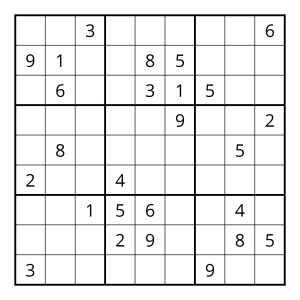 |
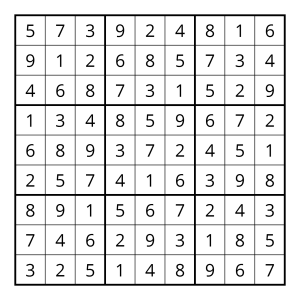 |
2. Sudoku 6 x 6
The rules for the 6×6 Sudoku are same as for 9×9. The only difference is that the numbers has to be from 1 to 6 in each rows, columns and sub-regions.
| Puzzle | Solution |
|---|---|
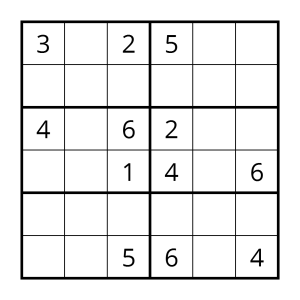 |
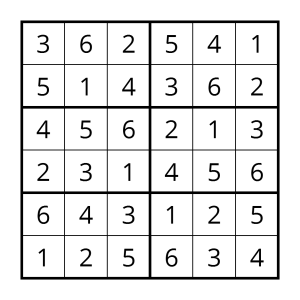 |
3. Sudoku X
This is a variation of regular Sudoku puzzle and is known as Sudoku X (“Diagonal Sudoku” or “Kokonotsu”). In this version, besides the general Sudoku rules, the main diagonals also contain the digits 1 through 9.
| Puzzle | Solution |
|---|---|
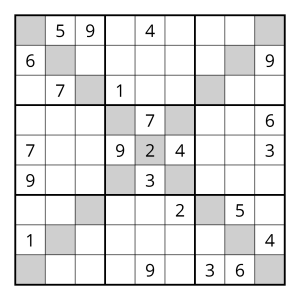 |
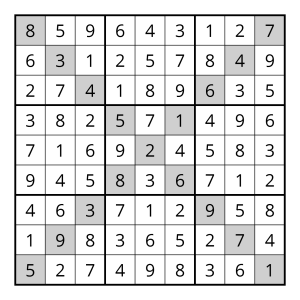 |
4. Jigsaw Sudoku
In this version of Sudoku puzzle the regions are of random or irregular shape. This is also known as Jigsaw Sudoku (“Geometry Sudoku”, “Geometry Number Place”, “Irregular Sudoku”, “Kikagaku Nanpure”). The rules are same as of standard Sudoku puzzle. i.e. each row, column and region / shape should contain numbers 1 through 9 exactly once.
| Puzzle | Solution |
|---|---|
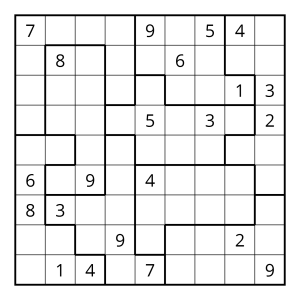 |
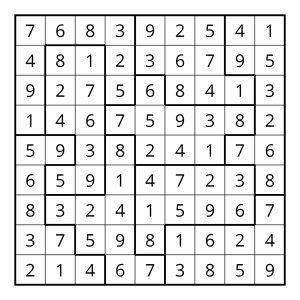 |
5. Bridges
In Bridges puzzle, the goal is to connect every island (represented by circle with numbers) into a single interconnected group. To do this, draw bridges (lines) between islands. The number in each circle states how many bridges must be connected to that island. Bridges cannot cross each other, and can only be drawn horizontally or vertically. There can be a maximum of two bridges between any pair of islands.
| Puzzle | Solution |
|---|---|
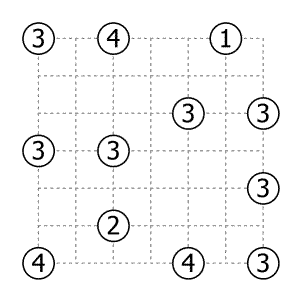 |
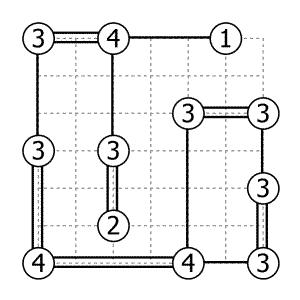 |
6. Futoshiki
Futoshiki (from Japanese, literally “not equal”; also known as “Hutoshiki”, “Unequal”) is a logic puzzle. The puzzle is played on a square grid, such as 5 x 5. The objective is to place the numbers 1 to 5 (or whatever the dimensions are) in each row, ensuring that each column also only contains the digits 1 to 5. Some digits may be given at the start.
In addition, inequality constraints are also initially specified between some of the squares, such that one must be higher or lower than its neighbor. These constraints must be honored as the grid is filled out.
| Puzzle | Solution |
|---|---|
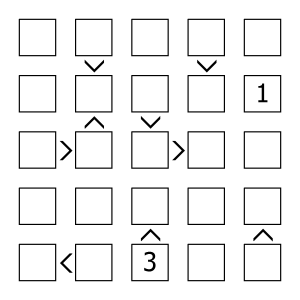 |
 |
7. Killer Sudoku
Killer Sudoku is similar to regular Sudoku with some constraints. In Killer Sudoku, sub-regions have specified sums, and no number can be repeated within a region. This variant also called “Sums Sudoku”, “Sums Number Place”, “Samunamupure”, “Kikagaku Nampure”.
| Puzzle | Solution |
|---|---|
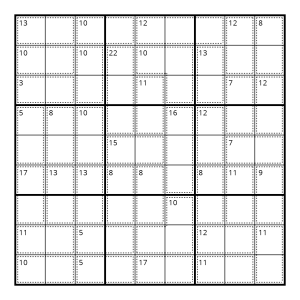 |
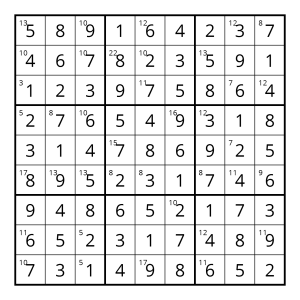 |
8. Even Odd Sudoku
In Even Odd Sudoku, the rules are similar to regular Sudoku; i.e. fill in the grid so that every row, every column, and every 3 x 3 box contains the digits 1 through 9. Cells with gray circles must contain odd digits, cells with gray squares must contain even digits.
| Puzzle | Solution |
|---|---|
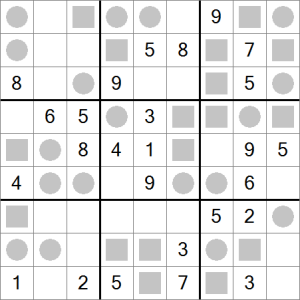 |
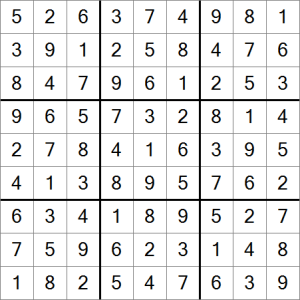 |
9. Samurai Sudoku
In Samurai Sudoku, the 5 regular Sudoku puzzles are inter-connected in a flower fashion. The rules are similar to regular 9×9 Sudoku; i.e. fill in the grid so that every row, every column, and every 3 x 3 box contains the digits 1 through 9 or as per the size of the grid.
| Puzzle | Solution |
|---|---|
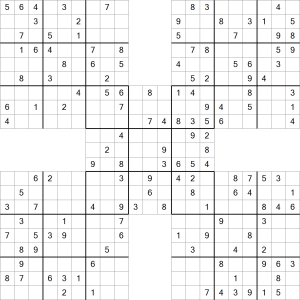 |
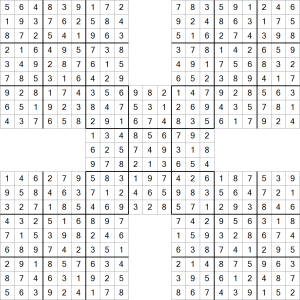 |
10. Kakuro
Kakuro (also known as “Cross Sums”) is a logical puzzle, a mathematical equivalent of crosswords. The puzzle consists of a playing area of filled and empty cells similar to a crossword puzzle. Some black cells contain a diagonal slash from top left to bottom right with numbers in them, called “the clues”. A number in the top right corner relates to an “across” clue and one in the bottom left a “down” clue.
The object of a kakuro is to insert digits from 1 to 9 into the white cells to total the clue associated with it. However no digit can be duplicated in an entry. For example the total 6 you could have 1 and 5, 2 and 4 but not 3 and 3.
| Puzzle | Solution |
|---|---|
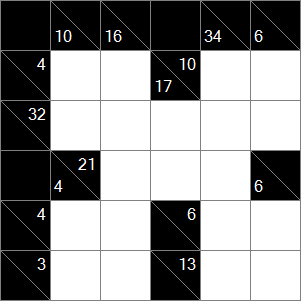 |
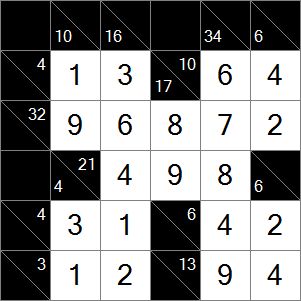 |
11. Star Battle
Star Battle consists of a square grid divided into regions. The goal is to place stars into some cells in the grid so that each row, column, and region contains the same number of stars. Stars cannot be placed in adjacent cells, not even diagonally.
| Puzzle | Solution |
|---|---|
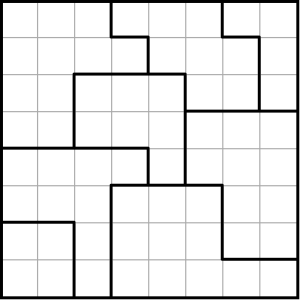 |
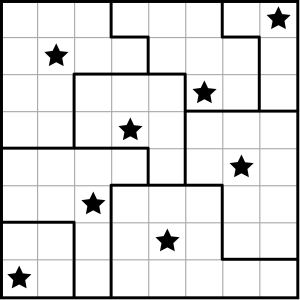 |
12. Magic Sum
A magic square of size N (say 4) is an array of 4 rows and 4 columns (N x N) containing numbers (usually positive integers) so that the sum of each row, each column and each diagonal are all equal to the same value, called magic sum (or magic constant).
| Puzzle | Solution |
|---|---|
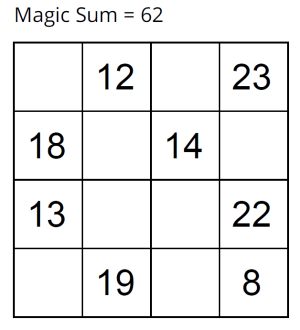 |
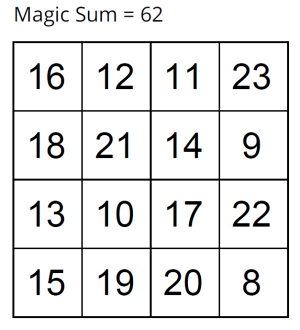 |
